I finished the hangerock/smokkr and wore it for that wedding in October, but I didn’t do the under dress.
I kind of didn’t do much related to the pentathlon for a little bit (my basement filled with sewage, and the shed is being replaced due to water damage, so my house is not a very usable space right now), but this week I got back to it.
Some reading I did a few weeks ago suggested Spælsau was the correct sheep for 10th century Danes to be working with, but I couldn’t figure out where to buy Spælsae fleece. They’ve also been interbred a fair bit recently. So I went for Icelandic instead. They’re pure-bred, no other sheep in Iceland for a thousand years, and they’re double-coated like Spælsau. They’re pretty similar, and they were found around Scandinavia at the correct time, so I think it’s close enough.
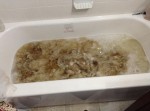
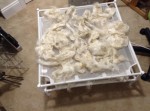
This week I washed a pound of Icelandic fleece and started combing it with the Valkyrie mini combs a friend lent me. Álfrún Ketta wanted to know how using 2-pitch combs is going, since most people use single row combs for double-coats. I’m not having trouble getting the thel off the combs, but I am intentionally stopping before it’s all off, simply because I don’t want all those neps and noils going into my worsted yarn! Well, then I looked up what Indigo Hound standard Viking one-row combs cost and ordered some. I’ll compare the output of both kinds of combs. They’ll show up while I’m out of town for the holidays.
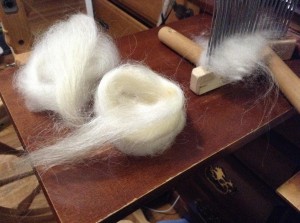
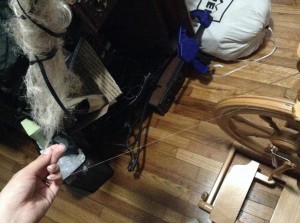
Speaking of being out of town for the holidays, I figure I’ll spend a lot of time during that trip hand sewing the under dress. I have a spool of linen thread, but it’s bleached, and the fabric isn’t, and I don’t really want my stitches showing, right? That’s ok, I’ve spun linen thread at two demos this year (because I knew everyone else would spin wool). When I unwound all the linen on my spindle and a bobbin a couple months ago, there was not enough to sew a whole dress. So I spun up what was left of my flax. The result was 13g and 104yd. If you do the math, that’s 3629yd/lb or 12 300yd hanks/lb, making it a size 12/1.
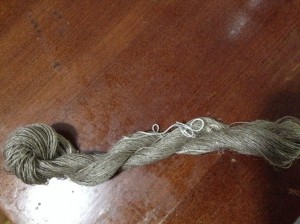
Can I sew a dress in 12 days? I’m doubtful, but we’ll see.
I’ve ordered a copy of Tools for Textile Production from Birka and Hedeby because that’s the book I’ve seen others citing regarding spindle whorls in Hedeby. From people citing it, it looks like the class I took on flat soft-stone whorls will be very helpful.
Then I’ll spin the Icelandic wool on a spindle using the stone whorl I’ve made. We’ll see, I might even manage 4 separate hanks:
- Worsted, 1-pitch comb
- Worsted, 2-pitch comb
- Woolen, wool carded from remainder of 1-pitch comb
- Woolen, wool carded from remainder of 2-pitch comb
I’m not sure there’ll be much noticeable difference between 1 and 2 or 3 and 4, but that’s why it’s an experiment, right?
I mentioned before nålbinding as a possible thing I’ll do. I did take a class on it in September, but I’m not aware of any particular artifacts from Denmark, so I need to do some more checking around.
I also need to spend some time over the holidays reading from NESAT X, Thor Ewing’s “Viking Clothing,” and Patricia Baines’ “Linen: Handspinning and Weaving,” among various other article I’ve got piled up, to get my documentation in order. At Baron Badouin (OL) ‘s suggestion, I’m converting what I’ve written so far into a set of reusable appendices. I’d like to make sure those appendices are well fleshed-out, though I know with every project I’ll find something that needs to be added to one of them.
And just to go into geek mode regarding that, I’m doing it with LaTeX, a typesetting language. I’ll have a file for each appendix and a file listing all my sources, and then I just include them at the end. There’s a bunch of configuration header that makes it so all the bibliography, table of contents, list of figures, etc. come out right when it generates a PDF. Here’s what it looks like:
\documentclass{report}
\usepackage{graphicx}
\usepackage[font=small,labelfont=bf]{caption}
\usepackage{units}
\usepackage[toc,page]{appendix}
\graphicspath{{../../SCA_includes/img/},{./img/},{/home/maco/Dropbox/SCA_includes/img/}}
\usepackage[nottoc]{tocbibind}
\begin{document}
\title{Icelandic wool yarn}
\author{Grazia Morgano}
\date{}
\maketitle
\tableofcontents
\listoffigures
\listoftables
\chapter{This project}
Project-specific documentation goes here
See the appendix on spindles (\ref{subsec:spindles})
\appendix
\input{../../SCA_includes/fibers.tex}
\input{../../SCA_includes/wool_prep.tex}
\input{../../SCA_includes/spinning.tex}
\bibliographystyle{plain}
\bibliography{../../SCA_includes/sources.bib}
\end{document}
Comments are closed.